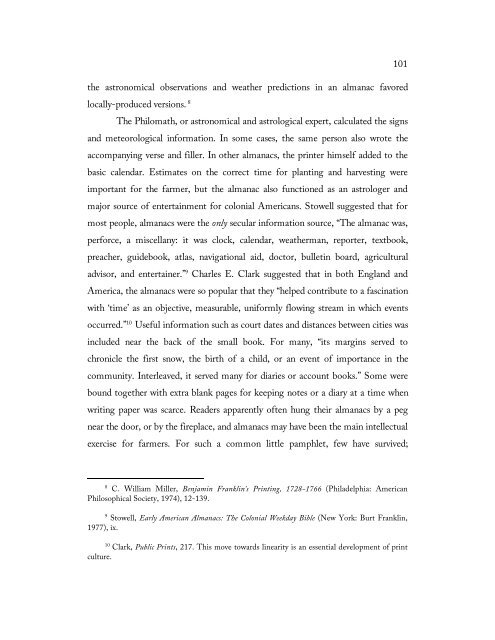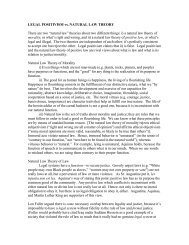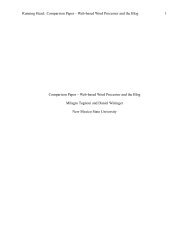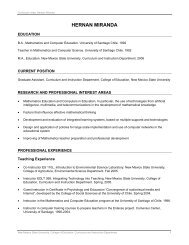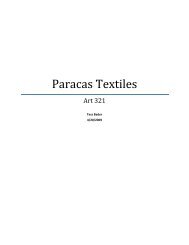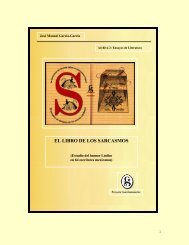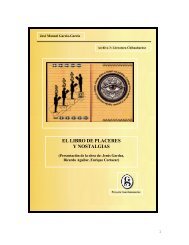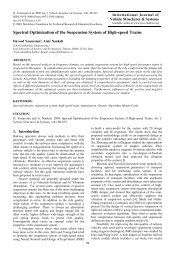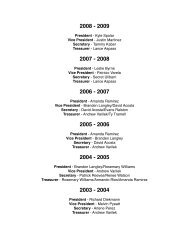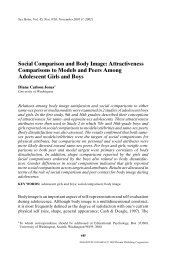- Page 4:
Dedication To my late father, Curti
- Page 7 and 8:
Chapter 7 Reactions in the Chesapea
- Page 10 and 11:
Foreword by David Waldstreicher Rog
- Page 12:
Acknowledgements This work could no
- Page 15 and 16:
2 typical of Colonial Virginians of
- Page 17 and 18:
4 political leaders, even the King,
- Page 19 and 20:
6 related, the relationship of prin
- Page 21 and 22:
8 the press, a declared freedom tha
- Page 23 and 24:
10 colony, and demonstrates how pri
- Page 25 and 26:
12 print and popular use of the pri
- Page 27 and 28:
14 expand, grow in importance, and
- Page 29 and 30:
16 in overcrowded conditions. Once
- Page 31 and 32:
18 in England that the colony had a
- Page 33 and 34:
20 sheets of those printed laws, Go
- Page 35 and 36:
22 to control dissent by the opposi
- Page 37 and 38:
24 was about 144,000 people, with a
- Page 39 and 40:
26 of the “simple folk.” 37 Thi
- Page 41 and 42:
28 and aristocracy, as they came mo
- Page 43 and 44:
30 journals made public. This appea
- Page 45 and 46:
32 A printing house was a major inv
- Page 47 and 48:
34 after the mid-eighteenth century
- Page 49 and 50:
36 percent and women’s about 30 p
- Page 51 and 52:
38 Whatever the original intent, pr
- Page 53 and 54:
40 Printing the laws, Eisenstein su
- Page 55 and 56:
42 Governor William Gooch was the a
- Page 57 and 58:
44 monopoly of power. 91 An increas
- Page 59 and 60:
46 Resolved, That it is the undoubt
- Page 61 and 62:
48 alienating anyone in power. 103
- Page 63 and 64: 50 approved by the Governor’s Cou
- Page 65 and 66: 52 that of a press that should cont
- Page 67 and 68: 54 ideas about the role of print wi
- Page 69 and 70: 56 and popular prints, more driven
- Page 71 and 72: 58 tells much about both the way th
- Page 73 and 74: 60 The earliest Chesapeake printers
- Page 75 and 76: 62 Printer William Parks noted that
- Page 77 and 78: 64 to found The Spectator with Jose
- Page 79 and 80: 66 public discourse. This appears t
- Page 81 and 82: 68 arrived in the Chesapeake via Lo
- Page 83 and 84: 70 Postal service was an extremely
- Page 85 and 86: 72 “Enter’d in the Upper Distri
- Page 87 and 88: 74 using an additional six pages of
- Page 89 and 90: 76 and relatives) made up the major
- Page 91 and 92: 78 more than two full pages of adve
- Page 93 and 94: 80 eventually gained in power, and
- Page 95 and 96: 82 issues. 63 The institution of th
- Page 97 and 98: 84 Hunter “be the Moderator of ou
- Page 99 and 100: 86 allow for a free exchange of a s
- Page 101 and 102: 88 improved communication, but news
- Page 103 and 104: 90 The limits of public debate in V
- Page 105 and 106: 92 criticism of the British governm
- Page 107 and 108: 94 Gentlemen. It was my unhappiness
- Page 109 and 110: 96 the power structure. From a pres
- Page 111 and 112: 98 from the multidisciplinary field
- Page 113: 100 Indian medicine. By the mid-eig
- Page 117 and 118: 104 While designed to be useful and
- Page 119 and 120: 106 One Maryland almanac had advice
- Page 121 and 122: 108 about political pamphlets and n
- Page 123 and 124: 110 the United States, but did not
- Page 125 and 126: 112 crisis, just as the tax on pape
- Page 127 and 128: 114 small amounts in the Virginia a
- Page 129 and 130: 116 opinion leaders. Such influenti
- Page 131 and 132: 118 permits separation of verbal th
- Page 133 and 134: 120 and alienation, it can also int
- Page 135 and 136: 122 dependent on the very culture i
- Page 137 and 138: 124 the knowledge they incorporated
- Page 139 and 140: 126 When printed material became a
- Page 141 and 142: 128 with interleaved pages. He reco
- Page 143 and 144: 130 This section included entertain
- Page 145 and 146: 132 it had real economic and social
- Page 147 and 148: 134 discourse, and even the public
- Page 149 and 150: 136 print remain under-explored. 9
- Page 151 and 152: 138 A fairly large number of Virgin
- Page 153 and 154: 140 as enabling discourse by non-el
- Page 155 and 156: 142 sold in Williamsburg in 1756. 2
- Page 157 and 158: 144 Complaint” begins by pointing
- Page 159 and 160: 146 a woman requesting a response f
- Page 161 and 162: 148 Pen.)” 49 This writer may hav
- Page 163 and 164: 150 Women’s involvement with prin
- Page 165 and 166:
152 mass media available. Communica
- Page 167 and 168:
154 equality, “One Sex was not de
- Page 169 and 170:
156 women’s involvement in the ph
- Page 171 and 172:
158 to the 1730s, to the very origi
- Page 173 and 174:
160
- Page 175 and 176:
162 ensued. In the summer of 1764,
- Page 177 and 178:
164 among the printers and between
- Page 179 and 180:
166 than two shillings. The tax on
- Page 181 and 182:
168 which openly invaded the first
- Page 183 and 184:
170 Extracts of Letters, &c. respec
- Page 185 and 186:
172 assembly what action he should
- Page 187 and 188:
174 Williamsburg paper did not ment
- Page 189 and 190:
176 successors to print laws and th
- Page 191 and 192:
178 While Royle did still receive
- Page 193 and 194:
180 Sentiments of their own Rights
- Page 195 and 196:
182 estimates that by this period,
- Page 197 and 198:
184 in Charles-Town, South Carolina
- Page 199 and 200:
186 in the colonies has been theori
- Page 201 and 202:
188 many as four or five coffeehous
- Page 203 and 204:
190 Jürgen Habermas viewed such ci
- Page 205 and 206:
192 with the religious Great Awaken
- Page 207 and 208:
194
- Page 209 and 210:
196 specifically from the former pr
- Page 211 and 212:
198 and Richard D. Brown noted, kno
- Page 213 and 214:
200 little afford to offend powerfu
- Page 215 and 216:
202 period and was more boring afte
- Page 217 and 218:
204 This author claimed that Royle
- Page 219 and 220:
206 Historians have generally agree
- Page 221 and 222:
208 1935 article, where he wrote,
- Page 223 and 224:
210 Rind, with only minor discrepan
- Page 225 and 226:
212 Street that belonged to Philip
- Page 227 and 228:
214 has ever been Established in th
- Page 229 and 230:
216 authority. 54 The newspaper in
- Page 231 and 232:
218 Judges of the General Court, ou
- Page 233 and 234:
220 was now political material with
- Page 235 and 236:
222 Going beyond questions of memor
- Page 237 and 238:
224 of deference was giving way to
- Page 239 and 240:
226 the United States’ Bill of Ri
- Page 241 and 242:
228 intended to “wipe out the com
- Page 243 and 244:
230 interpretation as being too nar
- Page 245 and 246:
232 business advantages that the fr
- Page 247 and 248:
234 the Virginia House of Burgesses
- Page 249 and 250:
236 “great bulwark of our Constit
- Page 251 and 252:
238 cultural customs and behavior.
- Page 253 and 254:
240 contending writers that pay the
- Page 255 and 256:
242 new burgess was not mentioned,
- Page 257 and 258:
244 that seditious libel was becomi
- Page 259 and 260:
246 restricting freedom of the pres
- Page 261 and 262:
248 attacks on Wilkes’ newspaper.
- Page 263 and 264:
250 colonial legislature in 1770, h
- Page 265 and 266:
252 part of our government can main
- Page 267 and 268:
254 George Mason and Rights Declare
- Page 269 and 270:
256 both Richard Henry Lee’s and
- Page 271 and 272:
258 paragraphs of Mason’s Declara
- Page 273 and 274:
260 There is no conclusive document
- Page 275 and 276:
262 Henry had arranged with printer
- Page 277 and 278:
264 ministry. 112 “A free press w
- Page 279 and 280:
266 Connecticut replied, “It is u
- Page 281 and 282:
268 heavy duties on the printing of
- Page 283 and 284:
270 means merely the absence of pri
- Page 285 and 286:
272 people peaceably to assemble an
- Page 287 and 288:
274 amendments, he informed the gov
- Page 289 and 290:
276 Despite the evidence underminin
- Page 291 and 292:
278 simply being a restriction on p
- Page 293 and 294:
280 himself—through the aid of pr
- Page 295 and 296:
282 While Habermas theorized about
- Page 297 and 298:
284 new contextualizing of the orig
- Page 299 and 300:
286 Americans instead of British. 1
- Page 301 and 302:
288
- Page 303 and 304:
290
- Page 305 and 306:
292 Congress, Great Britain PRO CO
- Page 307 and 308:
294 Charlottesville: published for
- Page 309 and 310:
296 Hoffman, Paul P., ed. Guide to
- Page 311 and 312:
298 Morton, Richard L. Colonial Vir
- Page 313 and 314:
300 Barker, Hannah and Simon Burrow
- Page 315 and 316:
302 Kraus, Sidney and Dennis Davis.
- Page 317 and 318:
304 Articles: Anderson, David. “T
- Page 319 and 320:
306 Smith, Stephen A. “The Origin
- Page 321 and 322:
308
- Page 323 and 324:
310 Bill of Rights, 4, 7, 11, 226,
- Page 325 and 326:
312 Dulany, Daniel, 180 Dunmore, Go
- Page 327 and 328:
314 King Charles, 21 King George I,
- Page 329 and 330:
316 North Briton, The, 223, 247, 24
- Page 331 and 332:
318 Rawson, David, 23, 36, 125, 155
- Page 333:
320 Virginia Resolves, 169 Virginia


